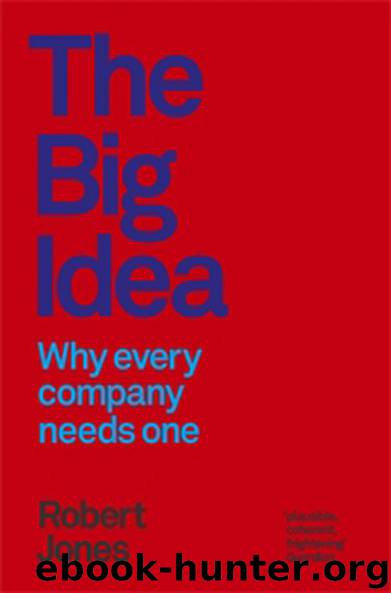The Big Idea by Robert Jones

Author:Robert Jones [Jones, Robert]
Language: eng
Format: epub
Publisher: Profile Books
Published: 2011-05-25T22:00:00+00:00
Sixty minutes and sixty years
How long does it take to find a big idea? Because it’s more a matter of instinct than research, it needn’t, in theory, take long. Organizations sometimes find that an hour of productive reflection by their senior team can generate more than months of arduous interviews, workshops and symposia. And some organizations are set up with a clear and explicit purpose: for them the creation of the big idea, and the founding of the organization, happen together, and sometimes in a very short space of time.
Yet organizations and their worlds change over time. For some, the pursuit of a big idea takes decades: occasional prods by the outside world take them a step further forward. For others, a small but interesting idea gradually becomes relevant and urgent to the outside world: it becomes a big idea whose time has come.
To create the John Lewis Partnership, John Spedan Lewis gave away his family business to its employees. That single act revealed the big idea behind John Lewis – ‘a better form of capitalism’ – with labour employing capital instead of capital employing labour, and aiming for non-adversarial relationships with all its stakeholders. The National Trust was founded in 1895 to make open spaces accessible to city dwellers: its foundation revealed immediately its core idea – protecting places of historic interest or natural beauty for the many to enjoy.
These two big ideas enjoyed a relatively short gestation. And yet both have grown – gained more dimensions – over time. Both organizations have survived and prospered and moved on, and in doing so have added to their original big idea. John Lewis has added new layers to ‘a better form of capitalism’, such as its pricing promise ‘never knowingly undersold’. The National Trust is now better known for protecting country houses than open spaces. Both, interestingly, have become mainstream, part of the British establishment, almost institutions. But both are still, in their quiet and unassuming ways, radical. John Lewis is still the most successful model of a worker’s co-operative, taking a stand against the fashion for demutualization. And the National Trust, in its current stand against hunting, is still prepared to challenge the countryside establishment. And, at the end of the twentieth century, both organizations were devoting significant effort to reformulating their big idea. John Lewis were rewriting their constitution in ‘good, modern English’, and the National Trust is working on ‘a contemporary interpretation of the Trust’s purpose’.
Shiseido, Japan’s largest beauty products company, was similarly born with a big idea, and has added to it over the years. The company was set up in 1872 by Yushin Fukuhara, former head pharmacist to the Japanese admiralty. The Japanese characters Shiseido mean ‘praise the virtues of the earth, which nourishes new life and brings forth new values’. Big name, big idea. Yushin’s third son, Shinzo, studied art in New York, and brought American thinking back to the company. Cosmetics replaced drugs as Shiseido’s core business, and in 1921 Shinzo decided to make explicit the Shiseido big idea, in a set of five principles.
Download
This site does not store any files on its server. We only index and link to content provided by other sites. Please contact the content providers to delete copyright contents if any and email us, we'll remove relevant links or contents immediately.
The Brazilian Economy since the Great Financial Crisis of 20072008 by Philip Arestis Carolina Troncoso Baltar & Daniela Magalhães Prates(118547)
International Integration of the Brazilian Economy by Elias C. Grivoyannis(88363)
The Art of Coaching by Elena Aguilar(52890)
Flexible Working by Dale Gemma;(23242)
How to Stop Living Paycheck to Paycheck by Avery Breyer(19621)
The Acquirer's Multiple: How the Billionaire Contrarians of Deep Value Beat the Market by Tobias Carlisle(12213)
Thinking, Fast and Slow by Kahneman Daniel(12023)
The Radium Girls by Kate Moore(11899)
The Art of Thinking Clearly by Rolf Dobelli(10175)
Hit Refresh by Satya Nadella(9015)
The Compound Effect by Darren Hardy(8786)
Tools of Titans by Timothy Ferriss(8186)
Atomic Habits: Tiny Changes, Remarkable Results by James Clear(8157)
Turbulence by E. J. Noyes(7920)
A Court of Wings and Ruin by Sarah J. Maas(7620)
Change Your Questions, Change Your Life by Marilee Adams(7610)
Nudge - Improving Decisions about Health, Wealth, and Happiness by Thaler Sunstein(7544)
How to Be a Bawse: A Guide to Conquering Life by Lilly Singh(7360)
Win Bigly by Scott Adams(7078)
